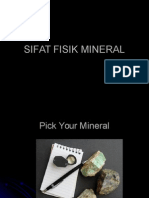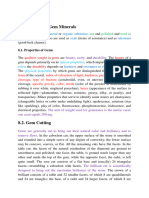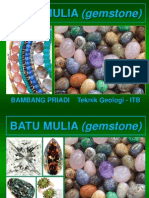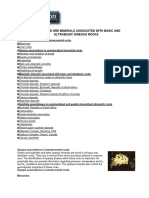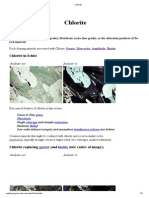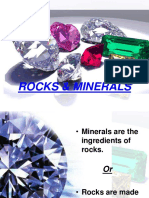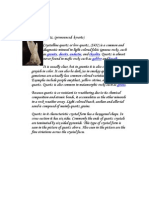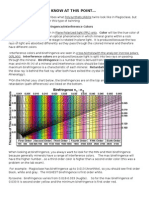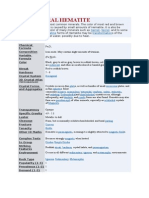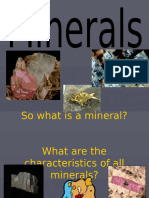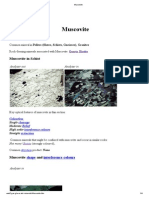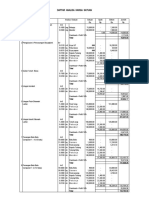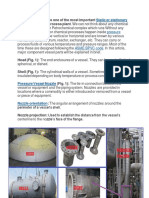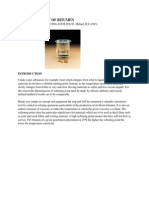Minerals Down The Microscope On Moodle
Minerals Down The Microscope On Moodle
Uploaded by
vasokosmCopyright:
Available Formats
Minerals Down The Microscope On Moodle
Minerals Down The Microscope On Moodle
Uploaded by
vasokosmOriginal Description:
Original Title
Copyright
Available Formats
Share this document
Did you find this document useful?
Is this content inappropriate?
Copyright:
Available Formats
Minerals Down The Microscope On Moodle
Minerals Down The Microscope On Moodle
Uploaded by
vasokosmCopyright:
Available Formats
22/5/13
Accessory minerals
Minerals down the Microscope on Moodle (back to intro)
Minerals down the Microscope on Moodle.
Part 2: Accessory minerals
These are typically very stable and commonly present as small crystals in a variety of igneous, metamorphic and sedimentary rocks but never present in large quantities. Hence they are not rock-forming minerals (i.e. the ca. 10 minerals that form the vast majority of rocks). Minerals covered on these pages: Zircon Apatite Titanite Tourmaline Opaques (Fe-oxides, Fe-sulphides)
Zircon
Rock types in which zircon is commonly present: Granites , Intermediateigneousrocks , Sandstones , Schists , Gneisses (Generally present in all silicate rocks except ultrabasic igneous rocks) Zircon in mylonite Analyser out Analyser in
Optical properties of zircon High relief High order interference colours Shape: Typically euhedral (igneous) or well rounded Forms pleochroic haloes in biotite Minerals that might be confused with zircon Titanite (higher interference colours) Zircon shape, interference colours and pleochroic haloes Zircon in metasedimentary gneiss
web2.ges.gla.ac.uk/~minerals/Accessory_minerals.htm#Zircon 1/7
22/5/13
Accessory minerals
Analyser out
Analyser in
Zircons in granite (note darker biotite adjacent to zircon) Analyser out Analyser in
Zircon in schist Analyser out
Zircon in metasedimentary gneiss Analyser in
Note: Dark spots (pleochroic haloes) in biotite caused by radiation damage from small inclusions of zircon in the biotite. At high magnifications, some larger zircons may display internal zoning either picked out by small differences in relief or interference colours. In igneous rocks zircon typically has good crystal shape, in clastic sedimentary rocks and metasediments it tends to be well rounded.
Apatite
Rock types in which apatite is commonly present: Granites , Intermediate igneous rocks , Sandstones , Schists , Gneisses (Generally present in most silicate rocks except ultrabasic and basic igneous rocks)
web2.ges.gla.ac.uk/~minerals/Accessory_minerals.htm#Zircon 2/7
22/5/13
Accessory minerals
Apatite inclusions in amphibole Analyser out
Apatite in orthogneiss Analyser out
Optical properties of apatite Colourless Moderate relief Low order interference colours Shape: Typically euhedral slightly elongate prisms (hexagonal x-section) Minerals that might be confused with apatite Quartz and feldspar (low relief and typically abundant) Apatite shape and interference colours Apatite in granite Analyser out Analyser in
Apatite in gneiss Analyser out
web2.ges.gla.ac.uk/~minerals/Accessory_minerals.htm#Zircon
3/7
22/5/13
Accessory minerals
Note: Higher relief that adjacent quartz, typical hexagonal; cross section and low interference colours. Hexagonal sections are typically completely dark in crossed polars.
Titanite
Rock types in which titanite is commonly present: Intermediate igneous rocks , Metabasic rocks , Calcsilicates Titanite in granite Analyser out Analyser in
Optical properties of titanite High relief V. high order interference colours Shape: Diamond shaped in igneous rocks Minerals that might be confused with titanite Garnet (isotopic), Calcite (lower relief), Zircon (lower interference colours) Titanite shape and interference colours Titanites in metabasic rock Analyser out Analyser in
web2.ges.gla.ac.uk/~minerals/Accessory_minerals.htm#Zircon
4/7
22/5/13
Accessory minerals
Note: Little change in colour of titanite when analyzer inserted due to very high interference colours. Metamorphic titanite tends to be less well shaped and may form a reaction rim around Fe-Ti oxides
Tourmaline
Rock types in which tourmaline is commonly present: Schists , Gneisses , some Granites Tourmaline in mica schist Analyser out Analyser in
Optical properties of tourmaline Moderate relief Strongly coloured (often zoned) Moderate order interference colours Shape: Generally euhedral elongate with curved triangular cross section Elongate sections are pleochroic Minerals that might be confused with tourmaline Amphibole (Cleavage) Biotite (Cleavage, pleochroic scheme) Tourmaline shape and interference colours Tourmaline in mica schists web2.ges.gla.ac.uk/~minerals/Accessory_minerals.htm#Zircon
5/7
22/5/13
Accessory minerals
Tourmaline in mica schists Analyser out Analyser out
Note: Colour zoning indicative of compositional zoning. Both biotite and tourmaline are strongly pleochroic but elongate sections of tourmaline are dark N-S, biotite is dark E-W
Opaques
(Oxides and sulphides tend to be opaque minerals e.g. Magnetite, Ilmenite, Pyrite) Most rocks contain some opaque minerals. Ilmenite tends to form slightly tabular crystals, Pyrite often forms cubes. Optical properties... dark with analyser out. All images with analyser out Ilmenite in biotite schist
Fine grained magnetite in basalt
Magnetite in peridotite
Fe-oxide cement in sandstone
web2.ges.gla.ac.uk/~minerals/Accessory_minerals.htm#Zircon
6/7
22/5/13
Accessory minerals
Take the Accessory Minerals test Return to top Return to introduction
web2.ges.gla.ac.uk/~minerals/Accessory_minerals.htm#Zircon
7/7
You might also like
- Wps Repair WorDocument1 pageWps Repair WorMajdi JerbiNo ratings yet
- BOQ For Toilet BlockDocument15 pagesBOQ For Toilet BlockAbhijit Das100% (1)
- Caustic Soda Storage and Handling TrainingDocument29 pagesCaustic Soda Storage and Handling TrainingJay Ann67% (3)
- Minerals Their Uses and OccurenceDocument9 pagesMinerals Their Uses and OccurencepriyanshuNo ratings yet
- Minerals Down The Microscope PDFDocument8 pagesMinerals Down The Microscope PDFArijit LaikNo ratings yet
- Soil MineralsDocument27 pagesSoil MineralsSumi SubiNo ratings yet
- Garnet - Rock-Forming MineralsDocument16 pagesGarnet - Rock-Forming MineralsMelroy DsouzaNo ratings yet
- Garnet in SchistDocument2 pagesGarnet in SchistvasokosmNo ratings yet
- W11-Stratigraphy Table 3.1Document2 pagesW11-Stratigraphy Table 3.1Bobby WskNo ratings yet
- Properties of MineralsDocument41 pagesProperties of MineralsBeverly DatuNo ratings yet
- Fundamentals of Soil Science Practical NotesDocument61 pagesFundamentals of Soil Science Practical NotesshubhNo ratings yet
- GraniteDocument16 pagesGranitepandieswari mNo ratings yet
- Chapter 2 - MineralogyDocument7 pagesChapter 2 - Mineralogytaniya paliwalNo ratings yet
- 11 Geography Notes 05 Minerals and RocksDocument10 pages11 Geography Notes 05 Minerals and RocksAkash100% (1)
- Identifikasi MineralDocument96 pagesIdentifikasi Mineralbudi91086No ratings yet
- Ilmenite: Ore MagnetiteDocument8 pagesIlmenite: Ore Magnetited3zarNo ratings yet
- CH-8 Introduction To Gem MineralsDocument3 pagesCH-8 Introduction To Gem MineralsMekonenNo ratings yet
- MineralsDocument40 pagesMineralsGhillian Mae GuiangNo ratings yet
- Introduction To GemologyDocument29 pagesIntroduction To GemologyFaizan KarimNo ratings yet
- Epidote Group: Presented by Sayantan Guha Dept. of Applied Geology NIT RourkelaDocument19 pagesEpidote Group: Presented by Sayantan Guha Dept. of Applied Geology NIT Rourkelaঅৰুনাভ বিষ্ণুকান্ত দত্তNo ratings yet
- DiamondDocument3 pagesDiamondYavor ShopovNo ratings yet
- Crystals, Gems and MineralsDocument5 pagesCrystals, Gems and MineralsResearchingPubNo ratings yet
- Chapter 3Document31 pagesChapter 3Sameer MahatoNo ratings yet
- BATU MULIA (Gemstone) : Bambang Priadi Teknik Geologi - ItbDocument74 pagesBATU MULIA (Gemstone) : Bambang Priadi Teknik Geologi - ItbMuhamad Firdaus Al-HakimNo ratings yet
- Materials On The Earth CrustDocument19 pagesMaterials On The Earth CrustMayur SharmaNo ratings yet
- Heavy Minerals and Magnetic SeparationDocument5 pagesHeavy Minerals and Magnetic SeparationMaster Geologia UsalNo ratings yet
- Atlas MineragrafiaDocument232 pagesAtlas MineragrafiaLaura RamirezNo ratings yet
- Chlo RiteDocument5 pagesChlo RitevasokosmNo ratings yet
- Yenite: Syenite Is Intrusive Igneous Rock That Basically Composed of An Alkali Feldspar and ADocument9 pagesYenite: Syenite Is Intrusive Igneous Rock That Basically Composed of An Alkali Feldspar and AArah Louise ApostolNo ratings yet
- Minerals CompressedDocument61 pagesMinerals CompressedHannah Joy Arrianne PascualNo ratings yet
- Quartz: - : Granite Diorite Andestie Rhyolite Gabbro BasaltDocument1 pageQuartz: - : Granite Diorite Andestie Rhyolite Gabbro Basaltapi-3808551No ratings yet
- MineralDocument3 pagesMineral24mt0092No ratings yet
- GLY 206 NOTE 6 - NesosilicatesDocument5 pagesGLY 206 NOTE 6 - NesosilicatesOdebunmi PaulNo ratings yet
- Color of MineralsDocument3 pagesColor of MineralsRafael Antonio Bernal VergaraNo ratings yet
- Earth and Life Lesson 3 MineralsDocument36 pagesEarth and Life Lesson 3 MineralsMagdalena TagubaNo ratings yet
- Geol 3208Document47 pagesGeol 3208Nay Myo TunNo ratings yet
- ES205Document43 pagesES205waustavaiqiaNo ratings yet
- Minerals of Igneous RocksDocument5 pagesMinerals of Igneous RocksKung KritsanaNo ratings yet
- Aggregates in ConcreteDocument14 pagesAggregates in ConcreterajasekharNo ratings yet
- MINERALSDocument5 pagesMINERALSDominador RomuloNo ratings yet
- Study of Rock-Forming MineralsDocument50 pagesStudy of Rock-Forming MineralsAlmira Legion PisngotNo ratings yet
- Lab Work For Metamorphic Rocks 2Document4 pagesLab Work For Metamorphic Rocks 2Wing Ching YeungNo ratings yet
- Physical Properties Minerals FinalDocument68 pagesPhysical Properties Minerals FinalSrajit BhardwajNo ratings yet
- High SulphidationDocument14 pagesHigh SulphidationTampan NauliNo ratings yet
- GEOmineralLAB 1 PDFDocument13 pagesGEOmineralLAB 1 PDFMino MinoNo ratings yet
- Earth S Materials and Resources-1Document83 pagesEarth S Materials and Resources-1Carlos TuazonNo ratings yet
- Rock IdentificationDocument7 pagesRock IdentificationRaghvendra singhNo ratings yet
- PE SC2015 Practical 1-5Document16 pagesPE SC2015 Practical 1-5Radu ChibzuiNo ratings yet
- Minerals and Its Properties-1Document21 pagesMinerals and Its Properties-1Siraj UddinNo ratings yet
- What Are They? Its Uses? How Are They Formed? How Are They Important?Document53 pagesWhat Are They? Its Uses? How Are They Formed? How Are They Important?IvyNo ratings yet
- The Most Common Form of Magnesite IsDocument7 pagesThe Most Common Form of Magnesite IsMubin Al DedeNo ratings yet
- Lecture Manual Geology For Civil Engineers (2.0 Units) III Petrology PDFDocument7 pagesLecture Manual Geology For Civil Engineers (2.0 Units) III Petrology PDFAd PlusNo ratings yet
- TX Bijih 2011Document22 pagesTX Bijih 2011Adrian LantapiNo ratings yet
- Chapter 2 - MineralsDocument54 pagesChapter 2 - Mineralsalvinllp83No ratings yet
- Beginning Optical Mineralogy Notes For Lab SectionDocument16 pagesBeginning Optical Mineralogy Notes For Lab SectionVanessa Carolina100% (2)
- Earth Science: Submitted By: Christian D. Gonzales Marjorie Q. ReformaDocument38 pagesEarth Science: Submitted By: Christian D. Gonzales Marjorie Q. ReformaLauriLeighQuevadaZumárragaNo ratings yet
- Mineral ADocument42 pagesMineral ASetya WibawaNo ratings yet
- The Mineral Hematite: (Click For Animated Model)Document1 pageThe Mineral Hematite: (Click For Animated Model)arvin4dNo ratings yet
- MINERALOGY Lectureslides PDFDocument63 pagesMINERALOGY Lectureslides PDFSuman TimalsinaNo ratings yet
- MineralsDocument50 pagesMineralsabiyouNo ratings yet
- Minerals StudentsDocument59 pagesMinerals StudentskairustabuzoNo ratings yet
- A Guide to Birthstones - A Collection of Historical Articles on the Gemstones Linked to AstrologyFrom EverandA Guide to Birthstones - A Collection of Historical Articles on the Gemstones Linked to AstrologyNo ratings yet
- Little Rocks & Small Minerals! | Rocks And Mineral Books for Kids | Children's Rocks & Minerals BooksFrom EverandLittle Rocks & Small Minerals! | Rocks And Mineral Books for Kids | Children's Rocks & Minerals BooksRating: 4 out of 5 stars4/5 (1)
- Grammar TargetsDocument2 pagesGrammar TargetsvasokosmNo ratings yet
- Measuring of The Wind Vocabulary ListDocument2 pagesMeasuring of The Wind Vocabulary ListvasokosmNo ratings yet
- PancakesDocument1 pagePancakesvasokosmNo ratings yet
- CrepesDocument1 pageCrepesvasokosmNo ratings yet
- Cordier It eDocument4 pagesCordier It evasokosmNo ratings yet
- Chlo RiteDocument5 pagesChlo RitevasokosmNo ratings yet
- Epidote: Epidote in Calc-SilicateDocument3 pagesEpidote: Epidote in Calc-SilicatevasokosmNo ratings yet
- Pla Gio ClaseDocument5 pagesPla Gio ClasevasokosmNo ratings yet
- Muscovite in SchistDocument4 pagesMuscovite in SchistvasokosmNo ratings yet
- Quartz in SchistDocument4 pagesQuartz in SchistvasokosmNo ratings yet
- Pyroxene: Clinopyroxene in BasaltDocument6 pagesPyroxene: Clinopyroxene in Basaltvasokosm100% (2)
- K-Feldspar: K-Feldspar (With Plagioclase Inclusion) in Granite and SimpleDocument4 pagesK-Feldspar: K-Feldspar (With Plagioclase Inclusion) in Granite and SimplevasokosmNo ratings yet
- CalciteDocument3 pagesCalcitevasokosmNo ratings yet
- Amphibole: Amphibole in Metabasic RockDocument5 pagesAmphibole: Amphibole in Metabasic RockvasokosmNo ratings yet
- Andalusite in SchistDocument3 pagesAndalusite in SchistvasokosmNo ratings yet
- Kathleen King's Double Chocolate Almond CookiesDocument2 pagesKathleen King's Double Chocolate Almond CookiesvasokosmNo ratings yet
- Environmental Remediation Technologies For Metal-Contaminated SoilsDocument257 pagesEnvironmental Remediation Technologies For Metal-Contaminated SoilsJhonatan Perez EspinozaNo ratings yet
- Contoh Rab RPHDocument52 pagesContoh Rab RPHdin mahyaNo ratings yet
- 13 31 00 - Fabric Structures PDFDocument7 pages13 31 00 - Fabric Structures PDFmasoodaeNo ratings yet
- Differential Pressure GaugesDocument2 pagesDifferential Pressure Gauges9033301054No ratings yet
- Influence of Dry Mixing and Distribution of Conductive Additives in Cathodes For Lithium Ion BatteriesDocument9 pagesInfluence of Dry Mixing and Distribution of Conductive Additives in Cathodes For Lithium Ion BatteriesMDRNo ratings yet
- Design of Anchor Channels - USA - JordahlDocument76 pagesDesign of Anchor Channels - USA - JordahlZlatko BiočićNo ratings yet
- Determination of PH Value in Mud FluidDocument18 pagesDetermination of PH Value in Mud Fluidn oNo ratings yet
- S.O.P 1Document7 pagesS.O.P 1vishvendanNo ratings yet
- Liquid LiquidMixinginStirredVesselsDocument4 pagesLiquid LiquidMixinginStirredVesselsAhmad HarisNo ratings yet
- Appendix-SF-Tolerances and Acceptance Criteria - Affordable and Mid PremiumDocument59 pagesAppendix-SF-Tolerances and Acceptance Criteria - Affordable and Mid Premiumsafety.godrejNo ratings yet
- The Recent Progress of Recycled Steel FiDocument20 pagesThe Recent Progress of Recycled Steel Fimanayagamaryjoy9No ratings yet
- Pipeline Soil InteractionDocument19 pagesPipeline Soil Interactionlama_fluidaNo ratings yet
- Mathcad 19 DeflectionDocument10 pagesMathcad 19 DeflectionJack Mayhua HuamanNo ratings yet
- MEP Production RatesDocument5 pagesMEP Production Ratesahmed HOSNYNo ratings yet
- Surface Energy-PET, PE, PPDocument9 pagesSurface Energy-PET, PE, PPShivaranjani KuruparanNo ratings yet
- Pressure Vessels PartsDocument3 pagesPressure Vessels PartssafwanNo ratings yet
- Lithium Intercalation in Moo3: A Comparison Between Crystalline and Disordered PhasesDocument6 pagesLithium Intercalation in Moo3: A Comparison Between Crystalline and Disordered PhasesIca AQNo ratings yet
- HT Mobilith SHC 460 EngDocument2 pagesHT Mobilith SHC 460 Engaxd123No ratings yet
- Packaging PPT MarketingDocument21 pagesPackaging PPT Marketingatul yadav100% (2)
- Practice Past Papers DP HL Only, S 1.1-1.5, S 2.1-2.2, R 2.1 AKDocument9 pagesPractice Past Papers DP HL Only, S 1.1-1.5, S 2.1-2.2, R 2.1 AKalwafa.q6rNo ratings yet
- Build An AtomDocument8 pagesBuild An AtomJeric VillamilNo ratings yet
- Gas Metal Arc WeldingDocument16 pagesGas Metal Arc WeldingAizad IzzuddinNo ratings yet
- TI+Multilayer+Tablets US 2014Document4 pagesTI+Multilayer+Tablets US 2014raju1559405No ratings yet
- Softening Point of BitumenDocument8 pagesSoftening Point of BitumenVanithaa Ponnaiah100% (3)
- Nsce 65-160 - 150 - P25VCC4Document4 pagesNsce 65-160 - 150 - P25VCC4Weird StrangerNo ratings yet
- ME6201 2012fall HW6 Solution PDFDocument6 pagesME6201 2012fall HW6 Solution PDFFaridehNo ratings yet
- Dipak Kumar Sarker - Packaging Technology and Engineering - Pharmaceutical, Medical and Food Applications-Wiley-Blackwell (2020) PDFDocument527 pagesDipak Kumar Sarker - Packaging Technology and Engineering - Pharmaceutical, Medical and Food Applications-Wiley-Blackwell (2020) PDFHồ ĐạtNo ratings yet














